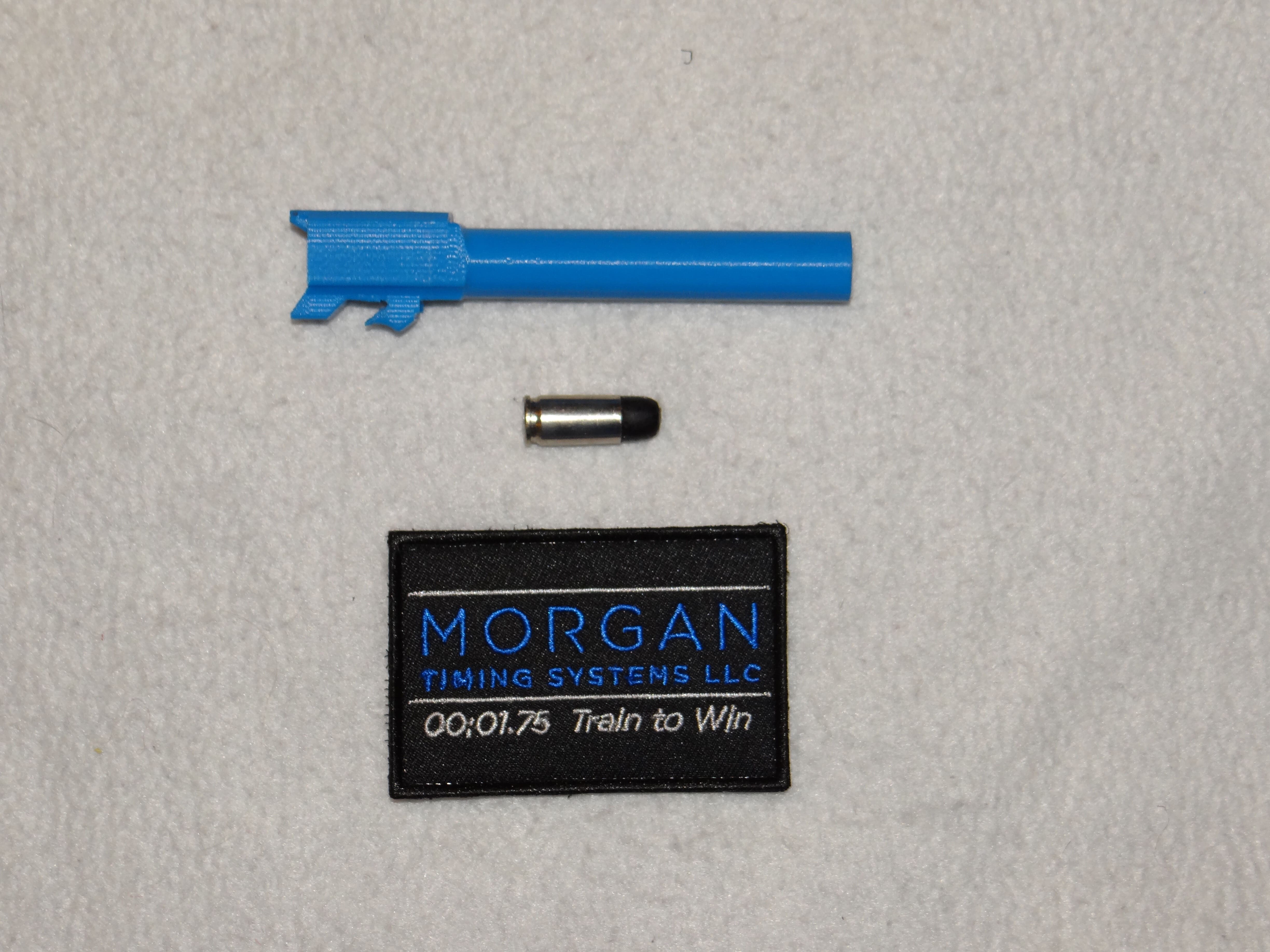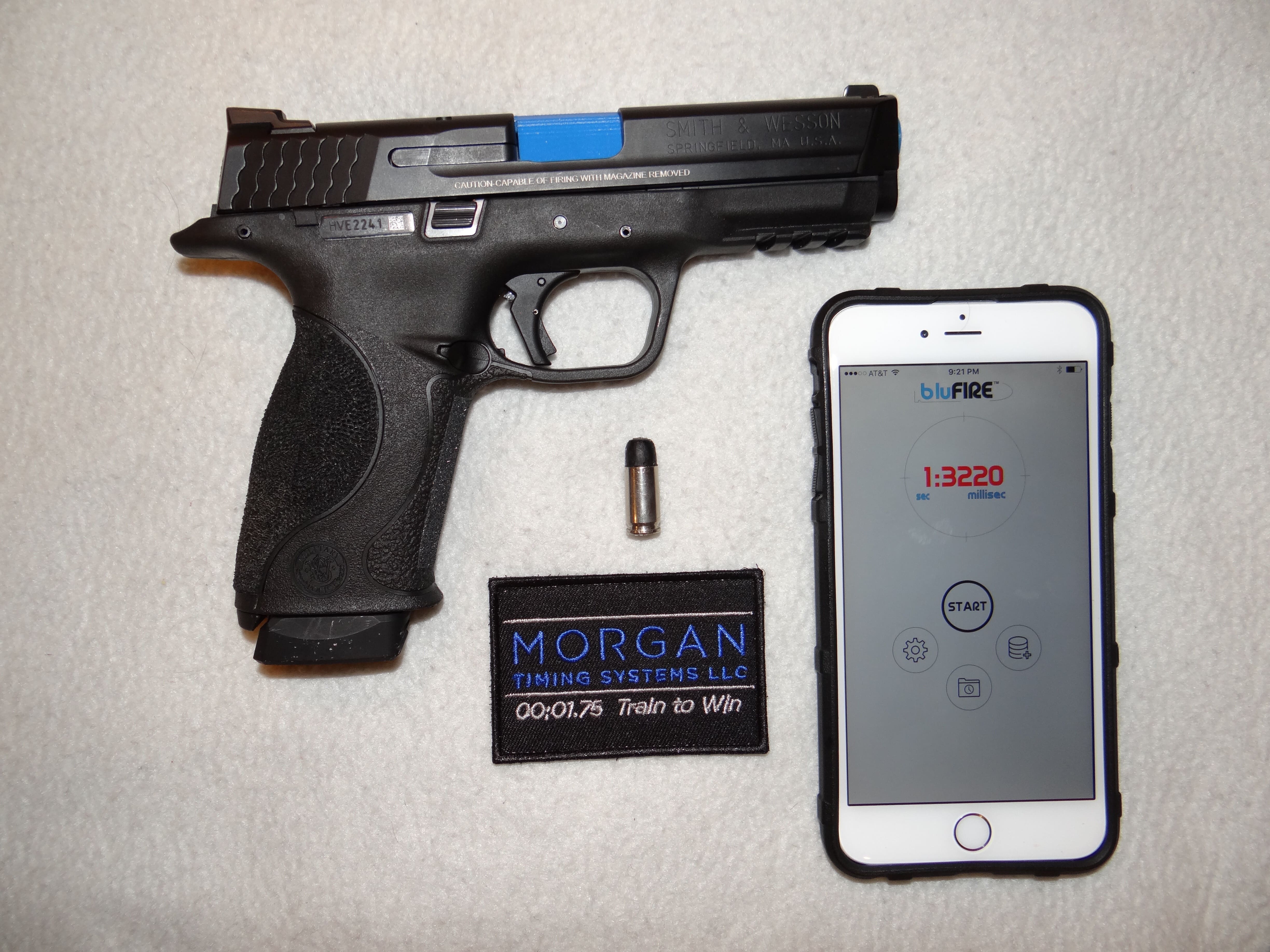I saw the Dry-Fire ProTimer at SHOT Show. It was created by a Veteran of the 75th Ranger Regiment in order to facilitate dry fire practice with a pistol. In particular, it’s very good at working on draw and presentation. It utilizes a replacement barrel, training cartridge and timer app. One important note is that the training barrel won’t chamber a live round in the proper caliber (of course, smaller rounds will fit).
The Dry Fire Pro-Timer training device (Patent pend. #) allows the user to receive immediate timing feedback when practicing shooting drills such as draw stroke, magazine changes, clearing malfunctions, and transitioning from a primary to secondary weapon system without having to fire live rounds. The recorded times are accurate down to one-thousandths of a second, and stored on a smartphone (through a downloadable App, included with purchase) enabling the user to compare speed and efficiency while utilizing different techniques and equipment.
Tags: Morgan Timing Systems




How is this any different than using snap caps and any other smartphone shot timer app? Are there electronics inside that special cartridge? Their website didn’t give any additional info.
Yes, the dummy round records your trigger pull.
Will it pick up multiple shots if used in a double action gun? Also, why did they go with a training barrel and non-standard size shell? It seems like if you made it to the dimensions of a standard snap cap you could use it in any gun of that caliber.
This.
Maybe theres a way to modify it onto a traditional snapcap.
Why? Their dummy round has the electronics built into it.
Because their dummy round is a non standard dimension, if they’d made it the same size as a normal bullet you could use it in any gun of that caliber in the same way you can with a traditional snap cap. Maybe there’s something important about the training barrel I don’t understand.
I assume the training barrel is designed so that you can’t accidentally chamber a live round during dryfire, which can be a hazard to even the most experienced shooters (Bill Jordan comes to mind.)
Making the round 9mm sized would allow it to work in any firearm, which would be nice. However the training barrel does add quite a bit to safety. Ultimately its a tradeoff between safety and versatility, favoring safety.
The training barrel is needed so the phone can communicate with the electronics in the casing. The shorter chamber is to prevent the slide from locking up with a live round.
“The training barrel is needed so the phone can communicate with the electronics in the casing.”
What gives you that idea?
The bullet appears to me to have a fake primer that is on a spring, inside the “bullet” is a BLE / Bluetooth smart module using a Beacon or SensorTag format that updates itself when it senses the “primer strike”… The phone is the bluetooth host in this case and starts the timer when the it buzzes, stops when all of a sudden a known bluetooth profile sends out a beacon or changes it mode to discoverable or some other quick indication…
Oh… What’s that you say? Yea, I design stuff like this. This system would have a latency absolutely no faster than 20ms but that hardly matters for the intended purpose.
The barrel should be doing nothing.
That is assuming they didn’t have any issues with stuffing the electronics inside the 9mm round – they shouldn’t have and it looks to me like that’s the case. But I guess there is potential they messed up and made the barrel house the BLE parts.
It’s in the round.
Must has! That is one of the coolest things I’ve seen from this SHOT.
Saw this out at SHOT as well….it’s a smart and simple design. Very solid training tool…and it will have a lot of application for folks deployed overseas that need to maintain their edge without having access to a range. Love it….defnitely buying one as soon as Ben Morgan finishes up the 1911 version!
Totally cool idea, very good fundamental builder….except…MASSIVE training scar builder with the short stroke of the slide to reset the trigger. I can’t even imagine how terrible it is to ingrain in a shooter’s brain to constantly reach forward and pull just halfway back on the slide instead of a full motion. What do you think someone will do when they are really fighting and have a malfunction, and hear “click”…Instinctively reach forward and pull the slide halfway back and attempt to fight again. Nope, baddddddd idea to train this way.
BUT, imagine this tool with a Glock 17R. Would be the perfect combo, a dedicated training gun with a resettable trigger in it.
For years I have conducted dry fire training with either a snap cap or empty chamber on my service and personal weapons. Short stroking the slide to reset the trigger has always been a part of that training.
Along with the dry fire training iterations, we always conducted malfunction drills on the range with snap caps and live rounds in a magazine. Not once have I ever seen anyone short stroke a slide when the snap cap chambered and the “Click” occured. Most quality shooters would perform the malfunction drill by racking the slide completely and then visually diagnosing the malfunction and clearing it.
Dry firing can be used for many training situations like breaking bad habits to improving draw sequence speeds. The ability to separate a training environment event (such as this device offers) and an actual combat/shoot situation relies upon the ability of the shooter to discern between the two events completely.
You train as you fight and a big part of that is knowing when your training or doing PCI’s and getting ready to head out the wire! Guess its all in what you have been trained to do…..
This is a quality solution that will greatly allow a shooter to cut the time on their draw sequence through the trigger pull while benefiting from timed feedback.
The most common use will be to tune up presentation — either from the holster or a ready position. So each time you reset the trigger, you will also be resetting your position. I don’t see that process getting confused with an immediate action drill in the subconscious. If the user is really concerned about that, break the similarity by doing proper follow through, very deliberately lowering the pistol, THEN doing the reset.
Oh, you people and your “BUT MUH MUSCLE MEMORIES” garbage. You probably think competition shooters would also wait for the buzzer in a real firefight.
I’d estimate that I’ve dry fired my pistols over 50,000 times at this point, with a third of those being slide racks for trigger reset. Take a guess how many times I’ve half-stroked the slide during a malf…
(Hint, it starts with a “z”.)
“Oh, you people and your “BUT MUH MUSCLE MEMORIES” garbage. You probably think competition shooters would also wait for the buzzer in a real firefight.”
AWESOME COMMENT!!!
zillions? I bet it’s zillions!
/sarcasm
You got me. My malfs break the space-time continuum.
Brilliant. I will get one.